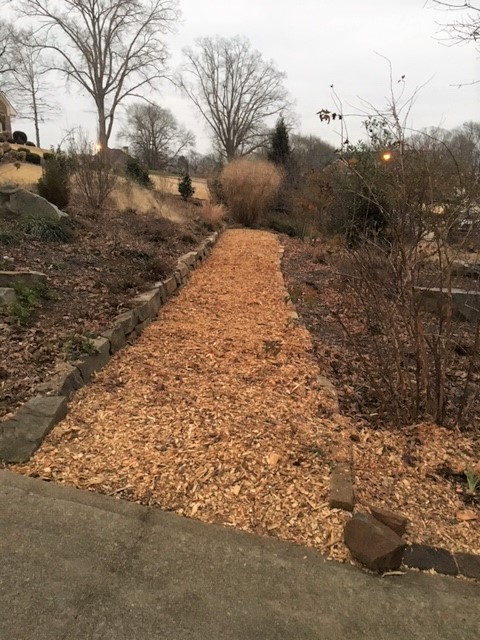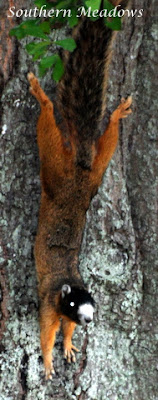Winter Garden Chores: Mulching
Just because the winter garden is dormant doesn't mean there isn't work to be done. Mulching is one of the most important chores for a healthy garden. If you live in a part of the world where you aren't under a blanket of snow, winter is a good time to refresh mulched areas. I would much rather shovel mulch in the cooler temperatures of winter than the heat and humidity laden summer.
Each year local arborists deliver several loads of free wood mulch to our garden. ChipDrop is a service you can register with and be matched with an arborist in your area needing to get rid of mulch. This process can take time depending on tree work happening in your area. Be patient.
When getting free mulch it is good to know why the tree was taken down. If it was infected with an invasive insect you definitely don't want to introduce it to your garden. If it was diseased, you can still use the mulch, but will want to let the mulch age for 6 months allowing it to heat up and start to compost, which will kill any potential disease pathogens.
We had a load of pine mulch delivered last week that smelled fresh and gorgeous. Free wood mulch isn't always the cleanest mulch, but it's free and removing some unruly sticks is not too tedious a task. Working with another person makes the task go more quickly. Our system is to have one person shovel mulch in a wheelbarrow while the other pulls sticks that didn't get well shredded. We use these sticks to create or add to existing brush piles, a place for wildlife to overwinter, evade predators, shelter from inclement weather, and forage for food.
My son and I made quick work of this wood chip pile getting it done in a day, motivated by the forecasted rain. Mulch was laid around the raised beds in the kitchen garden and on adjacent walking paths, approximately 2,720 sq. ft. It was a big task yet there is much more to mulch. We have a big garden and many paths to wander.
 |
| raised beds in kitchen garden. a layer of leaf litter covers those beds that are resting for the winter season. |
In the small orchard, we leave a perimeter of open soil around the base of the fruit trees to avoid trapping rot-causing moisture against the trunk and harboring rodents and insect pests. This is a recommendation I learned attending a class on fruit trees at the State Botanical Garden of Georgia.
No matter how experienced a gardener you are, there is always something more to learn. I highly recommend enrolling in classes at a local botanical garden, nature center, native plant society or Master Gardener program.
 |
| small apple orchard |
A fresh layer of wood mulch spruces up the garden and helps suppress pesky weeds, insulates the soil and keeps precious topsoil from washing away. We use wood mulch primarily where we don't want plants to grow [walkways].
Why not use wood mulch in planting beds?
Wood mulch will tie up nitrogen as it decomposes. Microorganisms use the low-nitrogen organic matter for food and take nitrogen from the soil. Once the organic matter is decomposed and the microorganisms die, the nitrogen is replenished to the soil. If you want to use wood mulch in garden beds, compost it first to avoid depleting the planting beds of nitrogen during the decomposition process.
Laying wood chips on top of the soil is beneficial, because the wood chips decompose slowly and only interact with the surface of the soil without impacting the nitrogen levels below the soil surface. Additionally wood is rich in lignin, suberin, tannins and other complex natural compounds slowly supplying nutrients back into the ecosystem.
Tip: as wood chips decompose, they add alkalinity to the soil, so if you have plants that prefer acidic soils be careful where you lay mulch.
In areas where we want plants to thrive we use leaf mulch. Leaf mulch is the best mulch for garden beds, because it provides habitat value while putting nutrients back into the soil, resulting in healthy plant growth. We are never short of leaf litter, with several acres of hardwood forest on our property, but we get even more leaves due to the generosity of our neighbors, who bring us their unwanted leaves. We have a special area right off our back driveway where they can empty their bags of leaves.
These donated leaves have been mulched already, so they are ready to be added to our garden beds. Each year we refresh the beds, first by incorporating old leaf mulch into the top soil to prevent the layers of mulch to become too deep. Then we add a fresh layer of leaves on top of the soil as a barrier. This insulates the plants, protects the ground dwelling insects and curbs the number of unwanted weeds. In our woodland garden this is done naturally by fallen leaves from the trees, but the full sun beds in the front and side gardens will be refreshed as the weather permits.
Garden chores are never ending and I enjoy the opportunity to be outdoors getting exercise and Vitamin N on warmer winter days. Plus this is one chore I can check off the spring to do list.





.png)
